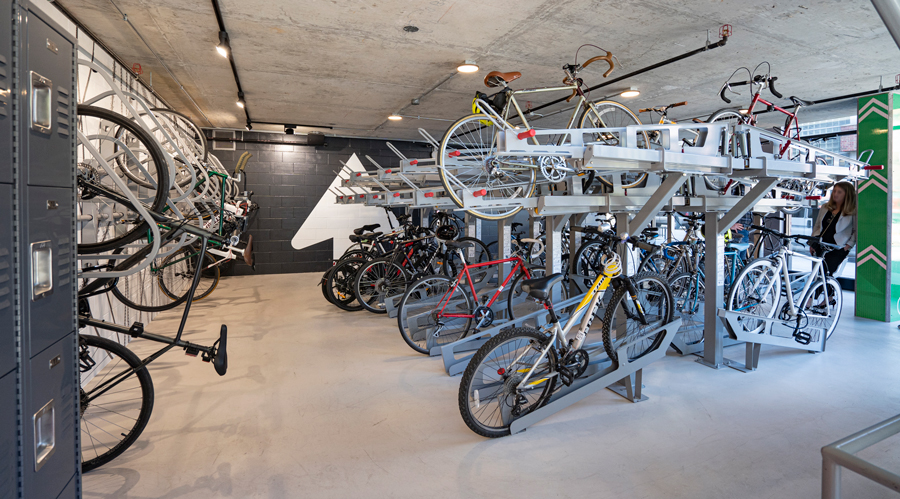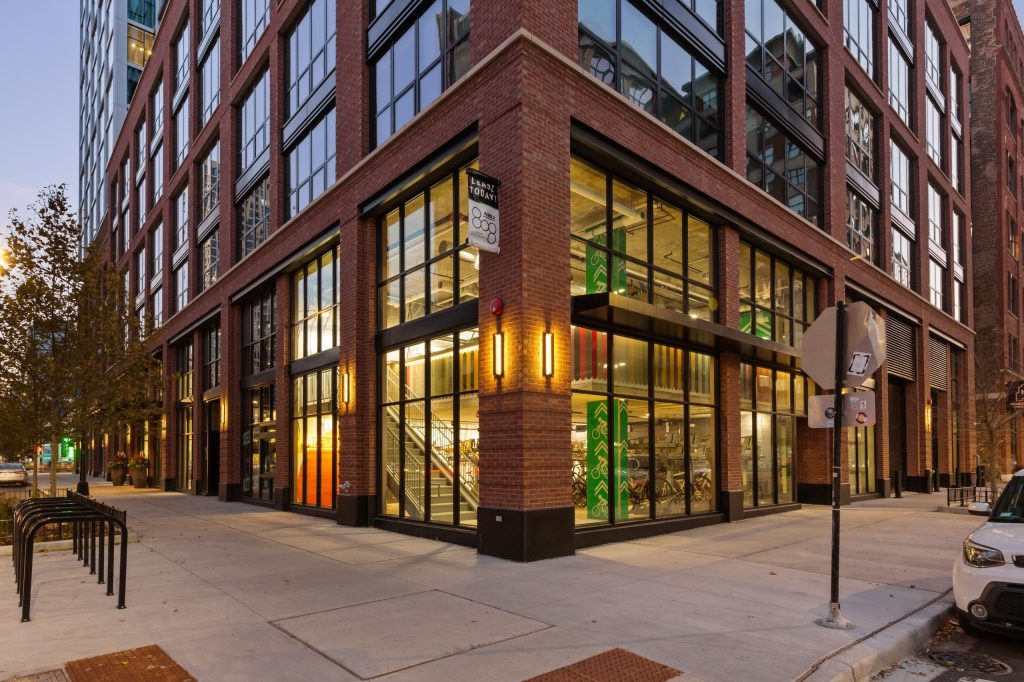More people than ever are bicycling around Chicago, thanks to the bicycling boom that emerged from the COVID-19 pandemic enticing people to hop on two wheels. But how do we maintain that momentum?
One way to keep people on their bikes is to have secure, accessible, and functional bike rooms in commercial and residential buildings—a key piece of infrastructure that may make the difference as to whether these new riders stick with cycling in the long term.
As more people take up bicycling for recreation and as their primary mode of transportation for commuting and errands, the need for enclosed bike rooms and bike parking grows.
“It’s a good idea to have secure indoor bike storage for commercial and residential buildings,” says Jason Jenkins, a sales representative with Dero Bike Racks and former education specialist at the Active Transportation Alliance. “Lots of people are not comfortable with storing their bikes for long periods of time outside. If you want people to ride their bikes regularly, especially as their main form of transportation, you’ve got to provide them with a safe place to store that bike at the beginning and end of their trip.”
DESIGNING A BIKE ROOM
A functional, practical bike room prioritizes security, convenience, and accessibility, according to Jenkins, who often consults with building owners interested in installing bike rooms. He recommends that a bike room be located on the first floor in a well-lit, climate-controlled enclosed space that is within 100 feet of an entrance to the building, allowing cyclists to easily access the exterior.
To ensure safety of the people using the bike room and prevent theft of their bicycles, the bike room door should be secured with a lock. Only people using the bike room and building staff should have keys, fobs, or a code to enter and exit the room. In addition, the bike racks should allow for U-lock compatibility, which lets an individual lock his or her U-lock to the bike frame, rack, and one wheel at the same time.

Bike racks play a vital role in maximizing space, accessibility, and capacity in a well-designed bike room, according to Jenkins. High-quality bike racks should have at least two points of contact with the frame of the bicycle to provide proper support for the bike.
If the space is small, two-tiered and vertical racks with lift-assist technology are optimal for high-density parking. And adequate aisle space between the racks is critical so people can maneuver their bikes and not feel cramped. Injuries and damage to bikes are more likely to occur when there isn’t enough space between the racks.
“The goal is to encourage more people to ride their bikes,” Jenkins says. “If every time someone wants to ride their bike and the first thing they’ve got to do is wrestle it down off a sketchy two-tiered bike rack that might fall, that’s going to be a hassle. You’re already setting up disincentives right at the beginning of getting people to ride bikes.”
Jenkins recommends including amenities in a bike room that provide convenience and create a socializing space for cyclists:
- Bench for putting on shoes, and a full-length mirror.
- Bike repair station with a tire pump and basic tools.
- Bike wash station to rinse dirt, salt, and other debris off bikes.
- Water station for filling water bottles.
- Electrical outlets for charging e-bikes.
- A community board for distributing bike maps and posting bicycling-related information, such items for sale and group bike rides.
- The highest quality bike rooms may also include sofas, locker, and showers, if budgets and the size of the rooms allow for them.
“We’re seeing a lot of bike rooms that are becoming more like bike lounges or community centers,” Jenkins says. “So rather than simply treating it as tenant storage, treating it as a community-building space.”
Peter Livaditis is a commercial real estate executive with a strong interest in getting more bike rooms built in Chicago commercial buildings so that more people will want to bike to work. Unfortunately, he says, bike rooms are too often an afterthought, and that access to them is often inconvenient or even dangerous. He says facilities are often not kept clean and offer poor quality racks and a lack of security.
Even the better-quality bike rooms, he says, are often missing key elements like adequate security, showers, lockers, and a place to change clothes. These amenities can be strong incentives in encouraging more people to bike to work, he says.
“People who arrive at a building on a bike should be on equal standing as pedestrians and those who arrive by car,” says Livaditis, who serves as executive vice president of the CBRE Group and serves on the Active Transportation Alliance Advisory Council. “We need to think about the user experience in bike rooms. Creating a frictionless experience will get more people to bike.”
Livaditis says that good bike rooms should be part of the wider discussion about bike infrastructure. “People need safe options for biking and they need safe and convenient places to park their bike indoors, as well,” he says.
GOING ABOVE AND BEYOND
Jenkins points to the new AMLI 808 apartment complex at 808 N. Wells St. in Chicago’s River North neighborhood as a good example of a bike room that is functional and creates community among its users. (See second, third, and fourth photos down.)
The two-story bike room has more than 300 bike parking spots—enough to accommodate each unit in the high-rise building. The two-level space also has four lockers for electric bikes or larger bicycles that don’t fit in standard bike racks. In addition, AMLI 808 installed bike racks in front of the building for guests. The bike room includes these features:
- Automatic doors on the ground level.
- A water filling station.
- Ramps on the stairway between first and second levels.
- Floor-to-ceiling windows and art from a local artist.
- Security cameras.
“Because we’re centrally located on one of the busiest bike lanes in the city, it was important for us to create a space that connects our amenities with the community,” explains Beric J. Wessely, community manager for AMLI 808. “We built our two-story bike facility as a central hub for our community.”

Livaditis estimates there are about 25 quality bike rooms in the Loop and West Loop. This is far too few for a city the size of Chicago, he says. What’s needed, he says, is a clearinghouse or database offering good examples of bike room designs and facilities that could be easily consulted by building owners.
According to Jenkins, bike rooms are not only useful for tenants, but they can also help buildings stand out and give them a competitive edge with prospective renters. “As leases come up for renewal and people start looking around, if they can find a newer, more modern building that also has this amenity, existing landlords can be looking at real competition if they’re not offering the same amenities,” Jenkins says.
“And in urban centers like Chicago and other cities, there’s been a continued trend towards people looking for non-motorized transportation, looking for ways to get around that are environmentally friendly, healthier for themselves and the environment, safer for themselves, and make their communities more livable,” says Jenkins. “So people are going to be looking for those types of amenities like good, quality bike parking that is safe, convenient, and easy to use.”

HOW TO GET A BIKE ROOM IN YOUR BUILDING
Although many commercial or residential buildings do not have the resources to create an upscale bike room like the one at AMLI 808, residents can still advocate for functional and practical bike rooms that won’t break the bank with their landlords. Here are some tips on how to get a bike room in your building.
Build a coalition. Identify fellow residents who would also like a bike room in your building. The more people asking for a bike room, the more amenable the management might be to it.
Ask for consultation. Encourage the landlord to contact Active Transportation Alliance or a company like Dero to help identify places where the bike room could be located and help with design of the bike room.
Create a proposal. If the building owners aren’t receptive to the idea of a bike room, there’s nothing to stop the tenants working with a company like Dero to develop a layout. You can then take the proposal to building management and use that to advocate for the bike room.
____________________________________________________
Photos courtesy of Dero and the AMLI 808. Second, third, and fourth photos down show the bike room at the AMLI 808 apartment complex at 808 N. Wells St. in River North.

